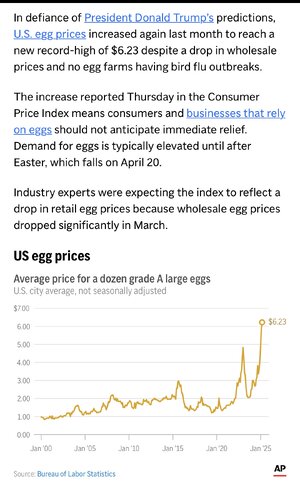- Messages
- 34,365
As egg prices soared at the supermarket, so did producer profits
A USDA program doled out hundreds of millions in relief payments to big egg companies, even as the largest earned record profits.GIFT LINK
“…
Cal-Maine, which produces about 20 percent of the nation’s egg supply, has benefited from the government program twice. After the virus led to the slaughter of 1.5 million hens at its facility in Chase, Kansas, the USDA paid Cal-Maine more than $22 million, according to the federal spending website, usaspending.gov, and outbreak reporting from the Centers for Disease Control and Prevention. Similarly, after the virus led to the slaughter of 1.6 million hens in Farwell, Texas, the USDA set aside $21 million for the company.
As a result, even though the avian flu reduced the ranks of the company’s hens by about 4 percent, the USDA payments and higher egg prices sent its profits soaring.
… The company isn’t even the biggest beneficiary of USDA payments so far. Hillandale, which has operations in Ohio and Pennsylvania, received $53 million, according to the federal figures. Versova, a family of companies with farms in Iowa and Ohio, has been allotted more than $107 million.
Those outfits, which are private, do not release profit figures. Neither does Iowa-based Rembrandt Foods, which received $26 million in payments when it was owned by billionaire Glen Taylor, according to local news reports at the time. It’s unclear whether Taylor, who did not respond to requests for comment, still owns a stake. Versova, Rembrandt Foods and Hillandale did not respond to requests for comment.
… While large producers with multiple far-flung locations like Cal-Maine may thrive during the outbreak, industry analysts said smaller farms stricken with the virus are far more likely to suffer — because while prices may be high, their single location may not be producing any eggs.
It can take months, even as long as a year, for smaller farms to restart production after an infection. The USDA payments defray the cost of the birds, but they do not pay for the down time in production.
While the USDA payments “do not come close to covering the financial toll when an egg farm must depopulate its flocks and rebuild its business, in many cases it means the difference between recovering or going out of business,” Emily Metz, president of the American Egg Board, said in statement.
“A larger egg producer with multiple locations is better equipped to survive the loss of a flock than a producer with a single location, but it’s important to know that regardless of the size of operations, a bird flu detection is absolutely devastating to any egg farm.” …”


